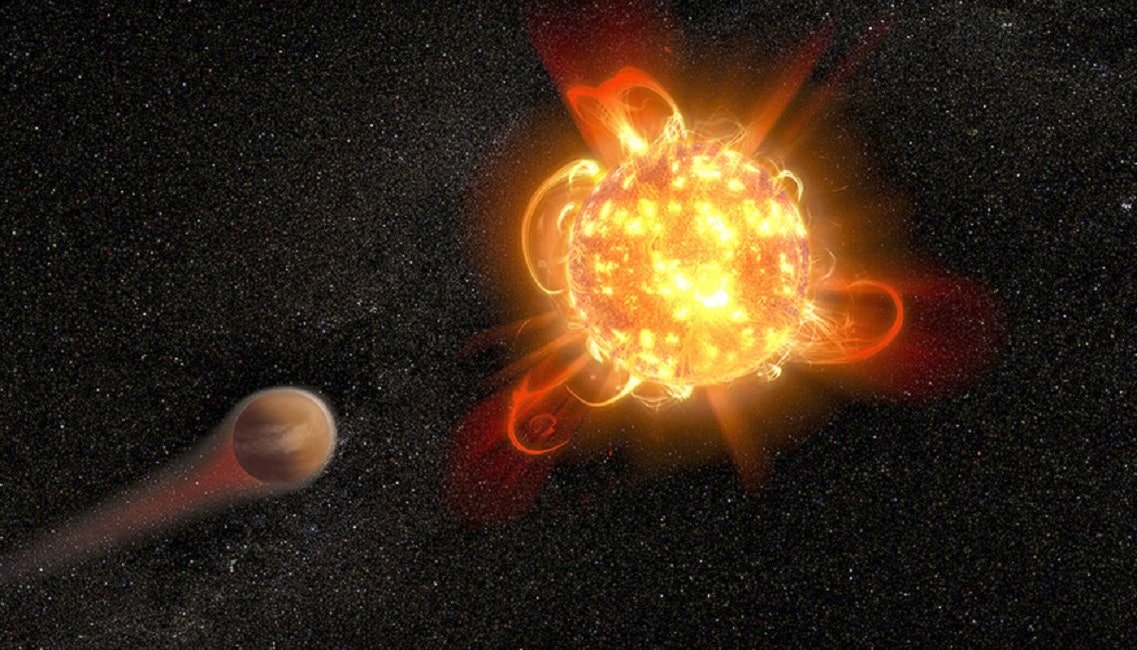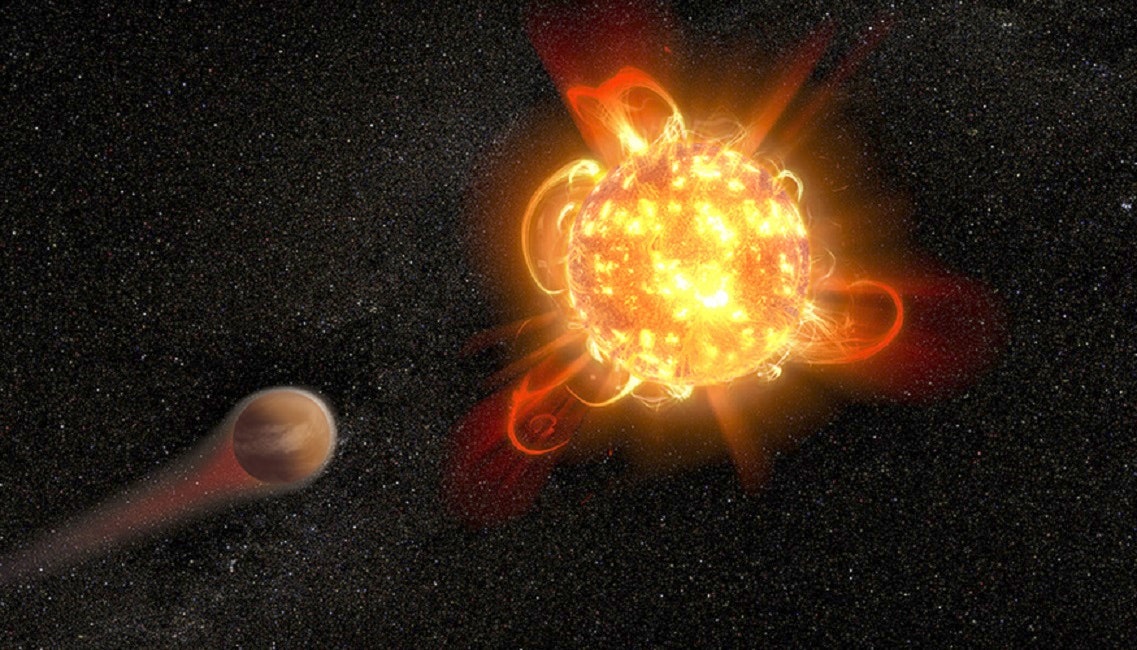
Seeing the atmospheres of rocky exoplanets isn’t going to be simple, even for JWST’s powerful instruments.
A team of astronomers hoping to measure the atmosphere of a rocky exoplanet called GJ486b recently spotted evidence of water vapor in their data. What wasn’t clear was whether they’d found water vapor in the planet’s atmosphere or in the outer layers of the red dwarf star it orbits. And the question highlights a challenge in the next phase of exoplanet astronomy.
Water Vapor in an Exoplanet Atmosphere? In This Economy?
University of Arizona astronomer Sarah Moran and her colleagues observed two transits of a rocky exoplanet called GJ486b with JWST’s NIRSpec instrument and found very clear evidence of water vapor. A transit happens when an exoplanet passes between its host star and Earth, allowing astronomers to measure any light that passes through.
That information can reveal whether the planet has an atmosphere and, if so, what it’s made of. Because various chemical compounds that would make up an atmosphere absorb specific wavelengths of light, noticing which wavelengths are missing can reveal first whether an atmosphere is present and second what it might be made of.
Stars are known to hold water vapor. Even our own Sun collects water vapor in its sunspots, which are cool, dark patches that appear temporarily on the surface of a star. These dark patches are so much cooler than the rest of the Sun’s surface that the molecules can collect there. Red dwarf stars like GJ486 are already so much cooler than our Sun (but still super hot, please do not touch) that their starspots can collect enough water vapor to look like a planet’s atmosphere in NIRSpec data.
“We didn’t observe evidence of the planet crossing any starspots during the transits, but that doesn’t mean there aren’t spots elsewhere on the star,” says University of Michigan, Ann Arbor, astronomer Ryan MacDonald, a co-author of the recent study, in a statement. “That’s exactly the physical scenario that would imprint this water signal into the data and could wind up looking like a planetary atmosphere.”
To solve the mystery, astronomers will have to find different ways to measure what’s going on with GJ486 and its rocky planet.
“The best mitigation is to take measurements over a wide range of wavelengths, where we should eventually be able to pick out the differences between star and planet because the star shouldn't be able to mimic a planetary signal across all colors,” Moran tells Inverse. “This does mean conclusive observations of these planets may be a little more time intensive than we'd like.”

Stars Keep “Contaminating” Astronomers’ Exoplanet Data
A big part of the challenge is that we simply don’t currently understand the inner mechanics of red dwarf stars like GJ486b and TRAPPIST-1 in much detail. Physicists haven’t yet mapped all of the details that determine things like how often a star has sunspots or flares, for example. Those gaps in our knowledge can make it difficult to build the kind of physics models that could help astronomers recognize a star’s light in a transit spectrum.
It’s a challenge that University of Montreal astronomer Olivia Lim, who studies the TRAPPIST-1 system, knows well. She and her colleagues are currently working on their own observations of TRAPPIST-1b, in which it’s currently too difficult to tell whether the signal they saw came from the star or from a faint atmosphere surrounding the planet.
A study published in March found that if TRAPPIST-1b has an atmosphere at all, it’s a very thin one. That study doesn’t rule out a thin atmosphere on the planet, but figuring out whether or not one exists is going to take more observations and a much better understanding of the star itself. According to Lim, a better understanding of the physics of the red dwarf star at the heart of the system is exactly what’s needed to create the kinds of detailed models that can help separate starlight “contamination” in the data from actual atmospheric signals.
“Long-term and in general, I think the more information we can get on the star, the better we will be at pinning down the contribution from the [star] in the transit spectrum,” Lim tells Inverse. Eventually, astronomers may be able to compare a transit spectrum to mathematical models of the star’s outer layers, predicting how starlight might “contaminate” the images of the planet’s atmosphere.
“However, and this is a big however, we would need accurate stellar models, and this does not exist yet for stars as cold as TRAPPIST-1,” Lim says.
Where Do We Go From Here?
Meanwhile, astronomers will have to find creative ways of looking at exoplanets in different wavelengths to suss out what’s going on. Moran and her colleagues want to take a second look at GJ486b with another JWST instrument called the Near Infrared Slitless Specrometer, or NIRISS.
“NIRISS would help because it will fully map out the shape of the water features at shorter wavelengths, rather than just catching the edge of one as our current study has done,” says Moran. “The shape of the water features should slightly change depending on whether the water is part of a planetary atmosphere or if the water is in starspots.”
A team led by University of Arizona astronomer Megan Mansfield will soon point MIRI at the dayside of GJ486b as the planet disappears behind the star and then reappears on the other side (astronomers call this a secondary eclipse). If the star is just shining down onto a bare rock, then the hottest point on the surface should be right beneath the star. But if there’s an atmosphere thick enough to move heat around the planet on its winds, then the hottest point on the surface should be someplace else, and the spot just beneath the star should be cooler than expected.
That would be, as Moran puts it, “a slam dunk detection for an atmosphere on the planet.” But if there’s no sign of an atmosphere circulating heat on the planet, it won’t mean there’s no atmosphere. It takes an atmosphere about as thick as Earth’s to move heat around on a planet’s surface; a thin atmosphere like the one on Mars might be invisible to Mansfield and her colleagues.
The upcoming MIRI observations are similar to observations done in a recent study on TRAPPIST-1b, which found that the TRAPPIST-1 system’s innermost world is either an airless rock or has, at most, a thin veil of an atmosphere. But unlike the earlier TRAPPIST-1 observations, Mansfield and her team will look at GJ486b with MIRI’s Low-Resolution Spectrograph, which will break the light from the secondary eclipse into its constituent wavelengths.
“If there's a large atmosphere, the MIRI team will measure the light filtered through the atmosphere at many different colors, so they should also be able to tell the composition of the atmosphere if it's there,” says Moran.
Volcanoes or Starpots? Cool Either Way
If GJ486b does turn out to have an atmosphere, that would make it an extremely interesting little world. A planet orbiting so close to its star should have long since had its atmosphere stripped away by radiation and solar wind from its star. If there really is an atmosphere, even a thin one, still clinging to the planet, it must be constantly rebuilt by steam erupting from the planet’s interior. The same is likely true of TRAPPIST-1.
On the other hand, if the water vapor turns out to be gathered in starspots on the star’s surface, that could shed some light on what makes red dwarfs like GJ486 tick.
Observations meant to search for planets’ atmospheres can also shed very useful light on their host stars, according to Moran.
“We get fantastic stellar measurements from doing these kinds of observations intended to measure the planet with JWST, better than we ever have been able to do previously,” says Moran. “Using these stellar measurements, we can understand the physics of these stars much better. This will let astronomers make better stellar models, which should help us untangle the planet and stellar signal. Being able to predict where, how many, and the temperature of these spots will give us a lot of insight into the magnetic and extreme ultraviolet behaviors that occur on these stars.”







